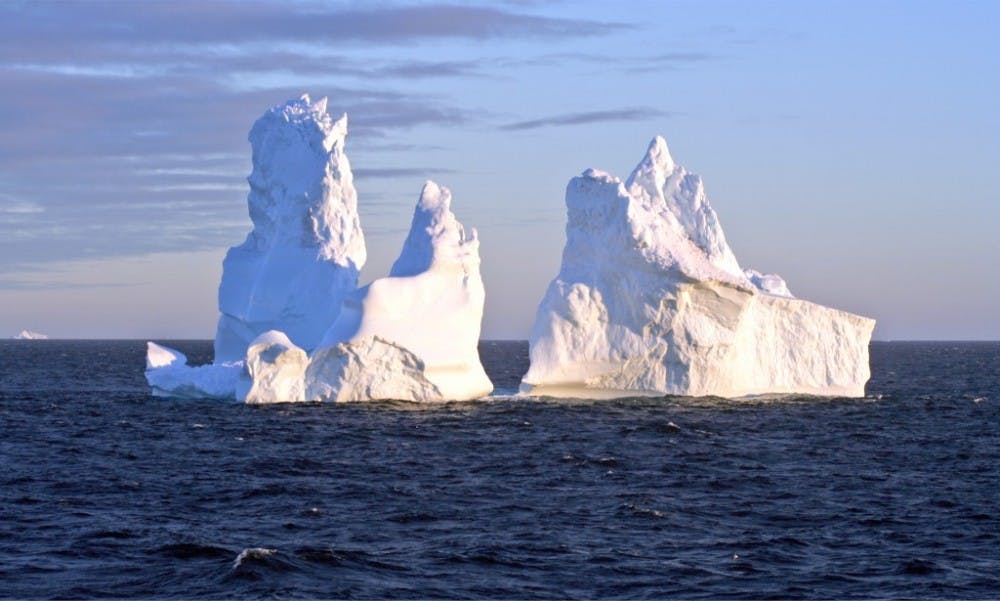A recent study done by the University of Sheffield’s Department of Geography discovered that water from melted giant icebergs supports extremely high levels of phytoplankton growth. This melted water contains iron and other nutrients and contributes to an activity known as carbon sequestration.
Under the direction of Professor Grant Bigg, a team of scientists analyzed 175 satellite images taken from 2003 to 2013. These images showed the ocean’s color, an indicator of phytoplankton productivity at the ocean’s surface. The photos were taken from a range of icebergs in the Southern Ocean, which were all more than 18 kilometers in length.
The study, published in the journal Nature Geoscience, analyzed these photos and determined that there was enhanced phytoplankton productivity near giant icebergs. This productivity has a direct impact on carbon storage. Furthermore, after studying the chlorophyll signal of a range of giant icebergs calved from around Antarctica, the researchers determined that this productivity extends hundreds of kilometers from giant icebergs and persists for at least one month after an iceberg passes out of a given area.
“This new analysis reveals that giant icebergs may play a major role in the Southern Ocean carbon cycle,” Bigg said in a press release.
Bigg added that several dozen giant icebergs are present in the Southern Ocean at any one time, and many can survive for several years.
“We detected substantially enhanced chlorophyll levels, typically over a radius of at least four to 10 times the iceberg’s length,” Bigg said. “The evidence suggests that assuming carbon export increases by a factor of five to 10 over the area of influence and up to a fifth of the Southern Ocean’s downward carbon flux originates with giant iceberg fertilization.”
Bigg added that the melting of these giant icebergs therefore may have bigger consequences than predicted. The negative feedback on the carbon cycle due to giant icebergs calving may alter the carbon in our atmosphere as well.
Bigg’s team also noted that the fertilization peaks of the giant icebergs are ahead of the iceberg itself. The lower production near the iceberg is probably due to the plume associated with the basal melting of the iceberg. The meltwater plume takes time to rise to the surface ahead of the iceberg. Driven by the surface ocean current, the fertilization levels then increase near the surface, transporting dissolved material. Furthermore, the team proved that there is no difference between the magnitude of fertilization effects in the summer and the spring.
In addition, the Southern Ocean is responsible for about 10 percent of the ocean’s total carbon sequestration. The ocean plays such a significant role due to biologically — and chemically-driven processes, including phytoplankton growth. In the Southern Ocean in particular, melting water from icebergs is responsible for nearly 20 percent of carbon sequestration.
The Southern Ocean contributes less to the ocean’s total carbon sequestration than the South Pacific and Indian Oceans, which are even smaller in area. This is because the low concentration of dissolved iron is an important nutrient for the production of phytoplankton. The Southern Ocean is a high-nutrient and low-chlorophyll region, and it is known to have a high concentration of bioavailable iron.
When these iron particles are dissolved, the enriched concentrations of dissolved iron in the meltwater plume at levels up to a thousand times the levels of dissolved iron that results when the ocean water interacts with atmospheric dust.
Though the trend of the giant iceberg calving is difficult to record over time, satellite gravity measurements suggested that there has been a five percent increase in ice discharge from Antarctica over the past two decades. Thus, as shown by Bigg’s team, carbon sequestration in the Southern Ocean may further act as a secondary negative feedback on climate change.





